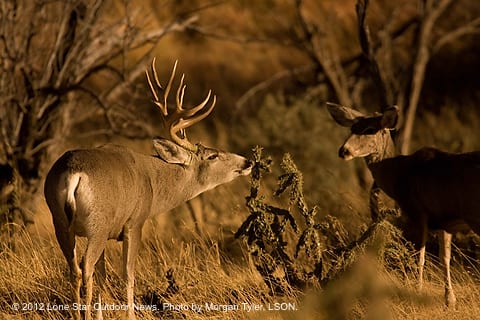 Texas officials have been warned that three recently harvested mule deer taken in New Mexico, several miles from Texas, have tested positive for Chronic Wasting Disease.
Texas officials have been warned that three recently harvested mule deer taken in New Mexico, several miles from Texas, have tested positive for Chronic Wasting Disease.
The deer were harvested in the Hueco Mountains, which extend into Texas northeast of El Paso in Hudspeth County. New Mexico has been monitoring annually for CWD since it was first discovered 10 years ago and this event is the closest to Texas that the disease has been detected. Texas also has had an active CWD-surveillance program for the past decade, and CWD has not yet been detected in the state. However, state wildlife officials have been preparing for the possibility since 2002.
“While this finding is not a big surprise, we’re not going to ignore it,” said Mitch Lockwood, Big Game Program Director for the Texas Parks and Wildlife Department. “We are working with TPWD’s Wildlife Health Working Group to develop a more intensive strategy for sampling, and to determine the geographical extent of the disease if it is detected in Texas.”
While several thousand deer have been tested for CWD in Texas, wildlife officials express concern that the Trans Pecos region is underrepresented because of the very low number of deer and the relatively low deer harvest in that region. Samples are obtained from hunter-harvested deer, deer found dead on public roadways and deer showing clinical symptoms. TPWD is determining how many more deer need to be sampled and deer hunters in the region could be asked for their assistance during the next hunting season.
“We are using disease models to determine the intensity of sampling that would be required to detect CWD in that deer population if it is present with a prevalence of at least two percent,” said Ryan Schoeneberg, Big Game Program Specialist with TPWD.
CWD was first recognized in 1967 in captive mule deer in Colorado and has also been documented in captive and/or free-ranging deer in nearly two dozen states and Canadian provinces, including New Mexico. Although fatal in deer, there is no evidence that CWD poses a risk to humans or livestock in the natural environment.
CWD is a member of the group of diseases called transmissible spongiform encephalopathies. Other diseases in this group include scrapie in sheep and goats, bovine spongiform encephalopathy (or mad cow disease) in cattle, and Cruetzfeldt-Jakob disease in people. CWD is a progressive, fatal disease that affects deer, elk, moose, and other cervid species and there is no vaccine or other biological method that prevents it.
“It would be almost impossible to eradicate the disease once it becomes established in a population,” Lockwood said. “But, what we can do is manage the disease and minimize the risk of it spreading.”


